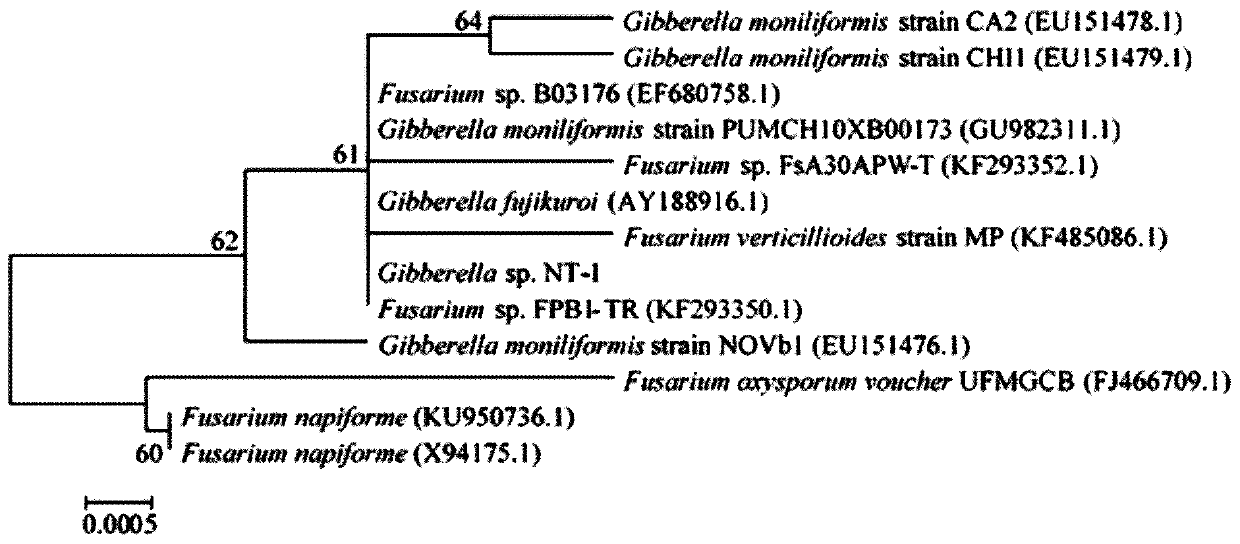Gibberella nt-1 and its application
A technology of gibberella and bacterial suspension, applied in the field of microorganisms, can solve the problems of inability to grow, poor tolerance, etc., and achieve the effect of wide application potential
- Summary
- Abstract
- Description
- Claims
- Application Information
AI Technical Summary
Problems solved by technology
Method used
Image
Examples
Embodiment 1
[0022] Embodiment 1: Isolation and identification of copper-resistant bacterial strain NT-1
[0023] (1) Isolation and screening of copper-resistant bacterial strain NT-1
[0024] The bacterial strain NT-1 of the present invention is isolated and screened from orchard soil where apples have been planted for a long time and copper-containing pesticide Bordeaux mixture has been sprayed. The separated media were basal medium (potato dextrose medium) and copper selective medium (CuSO 4 ·5H 2 O into Cu 2+ The concentration is 10g L -1 Add the stock solution of beef extract peptone basal medium and potato dextrose basal medium respectively to adjust to the required copper concentration). The solid medium is to add 20g L to the liquid medium -1 agar.
[0025] Separation and screening steps: take 5g of fresh soil samples and shake them in a conical flask filled with 50mL of sterile water for 20min to make a soil extract. The extract was diluted stepwise to 10 -3 、10 -4 、10 -...
Embodiment 2
[0032] Embodiment 2: the mensuration of growth curve of copper-resistant bacterial strain NT-1
[0033] Using the dry weight method, draw 1 mL of fresh strain seed liquid, inoculate it in a conical flask containing 50 mL of potato dextrose liquid culture liquid, cultivate at a constant temperature of 28 ° C and 150 rpm, and take out 3 parallel samples every 8 hours for suction filtration. The mycelia were dried in an oven at 80°C to a constant weight and weighed to draw a growth curve.
[0034] The growth curve of strain NT-1 is as follows Figure 4 shown. Under the conditions of 28°C and 150rpm, NT-1 entered the logarithmic growth phase 8 hours after inoculation, and entered the stationary phase after 96 hours.
Embodiment 3
[0035] Example 3: Tolerance characteristics and physiological responses of bacterial strain NT-1 to different concentrations of copper stress
[0036] Pick a ring of NT-1 mycelium and inoculate it on the Cu-containing 2+ Concentrations are 100, 200, 300, 400, 500 and 600mg L -1 The potato dextrose solid medium was placed in a constant incubator at 28°C for 5 days, the growth of mycelium on the solid plate was observed, and the diameter of the colony was measured and recorded.
[0037] The seed solution of strain NT-1 was inoculated in Cu-containing 2+ Concentrations are 100, 200, 300, 400, 500 and 600mg L -1 In the potato glucose liquid culture medium, culture in a constant temperature shaker at 28°C and 150rpm for 5 days, observe the growth of the strain in the liquid medium, centrifuge the strain and dry it at 80°C to constant weight, measure and record Mycelial biomass dry weight.
[0038] It can be seen from Table 1 that when NT-1 was cultured for 5 days, the 2+ Conce...
PUM
| Property | Measurement | Unit |
|---|---|---|
| diameter | aaaaa | aaaaa |
Abstract
Description
Claims
Application Information
 Login to view more
Login to view more - R&D Engineer
- R&D Manager
- IP Professional
- Industry Leading Data Capabilities
- Powerful AI technology
- Patent DNA Extraction
Browse by: Latest US Patents, China's latest patents, Technical Efficacy Thesaurus, Application Domain, Technology Topic.
© 2024 PatSnap. All rights reserved.Legal|Privacy policy|Modern Slavery Act Transparency Statement|Sitemap



